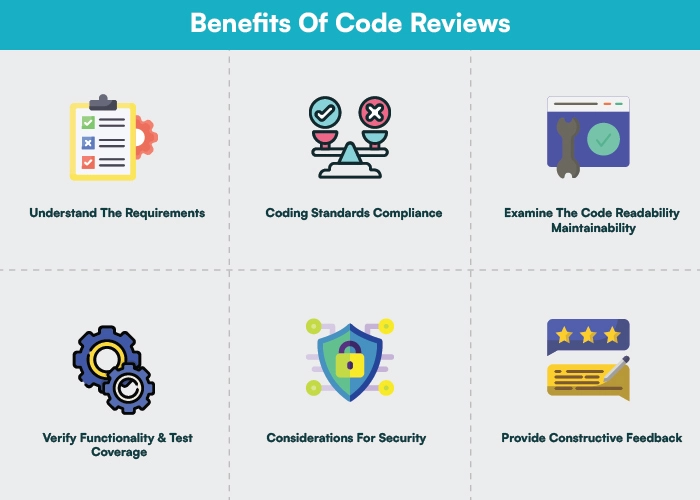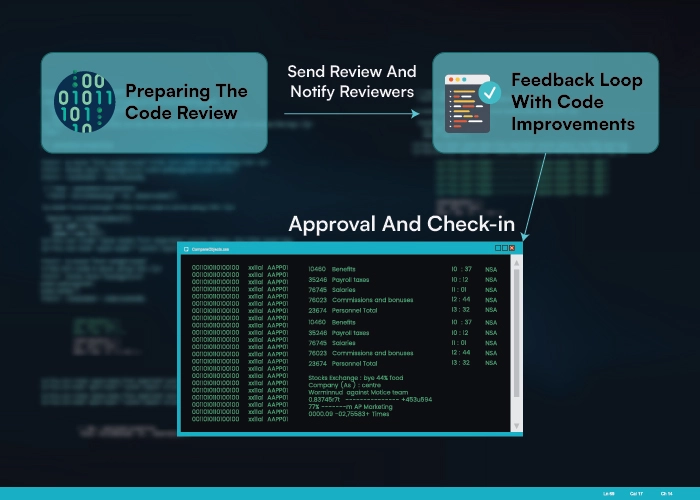Code Reviews are extremely beneficial to the health of a code base. During evaluations, you may uncover problems, find ways to improve security and performance, and much more. However, if you are not employing the optimal code review checklist, you may be unwittingly undermining your engineering productivity.
According to one research, developers must wait an average of four days for a pull request to be reviewed. That is a lot of downtime. Worse, we discovered that most of those evaluations ended with an “Looks Good To Me” style comment.
So, let’s look at what your team needs in a code review checklist, what they don’t, and how you can automate code review checklists by repo to increase developer experience, engineering efficiency and speed up product delivery.
According to a survey, 60% of developers consider code reviews to be “very valuable” for security and code quality. Respondents also mentioned code reviews as a bottleneck, citing strictness, taking too long, finding someone to finish a review, and not knowing how to conduct successful code reviews.
Continuing in the same vein. This blog will provide an overview of the code review checklist, its procedure, and the six primary steps you can take to improve the quality of your reviews. So, let’s start with the blog and recognize the best practices and crucial activities that should be implemented to increase the quality of your reviews.
What is a Code Review Checklist?
Code review is an important element of software development that includes both manual examination by a team and the use of automated code review technologies. The primary goal is to find problems, correct errors, and, more often than not, improve the general quality of the code.
Code review is commonly disregarded throughout the development process, despite its importance. Numerous studies have demonstrated its efficacy as a quality assurance approach. However, if code review is not given the attention it needs, it might have unforeseen repercussions, such as sessions lasting longer than expected. When code review is addressed, these unanticipated concerns frequently lead to a collective moan.
To avoid such issues, a proper code review process with well-defined escalation mechanisms must be established. This is especially important since without a standard method, businesses may lack knowledge of the effectiveness and even the frequency of their code audits.
The value of code review input affects the benefits of secure code review. Code reviews, when done appropriately, may help to assure a high-quality code base. However, if teams are unaware of and do not adhere to standard practices for code review, developers may face a variety of code review issues.
If you want to know more about a typical code review process, let’s a look into the same.
Typical Code Review Process:
The engineer often begins the tool-based code review process by preparing the code for review. The engineer then chooses appropriate reviewers for the code update. As a result, the reviewers are alerted. The reviewers then analyse the code for flaws, readability, and maintainability before providing input. The author of the code review works on the feedback until all parties are happy. The code is then integrated into the shared code base.
To ensure that the code review process runs smoothly and does not turn into a nightmare, it is critical to understand code review problems and the best practices for overcoming them.
The following are the primary code review challenges:
- Not obtaining valuable feedback.
- Not having enough time to complete code reviews.
- Code reviews consume a lot of time, causing significant waiting periods.
The code review best practices outlined below assist in mitigating these issues by making reviewers’ jobs as simple as feasible. They also assist the reviewer in focusing on offering useful input.

Code Review Best Practices to follow:
1. Keep reviews manageable in size and length:
Effective peer code reviews prioritize quantity over quality, restricting the number of lines of code (LOC) for review in one sitting. If you spend too much time examining code in a single session, or if you examine too many lines of code, your review may be less effective and complete (which negates the goal of a review). Our brains can only handle so much information once before we lose interest or cannot give it our full attention.
As a result, there are no hard and fast guidelines for organizing code reviews. The most essential thing is to discover a structure that works effectively for you and your teams and to prevent wasting time and energy in exchange for bad outcomes.
2. Compare code to standards rather than personal preferences:
Don’t allow code reviews to devolve into a forum for injecting nitpicky personal preferences in place of meaningful criticism. To get the most out of code reviews, the emphasis should be on meeting standards and maintaining quality. Managers and organizations must provide agreed-upon guidelines and sometimes a checklist to developers for the review to be successful.
Asking the author if you may meet separately for a knowledge transfer is one excellent approach for avoiding introducing personal preferences in a review. This allows teams to have healthy conversations and share expertise and best practices without causing a halt to the current codebase.
3. Provide constructive, succinct, and actionable feedback:
Reviewers should be objective and focused on improving the code. Furthermore, reviewers should avoid passing judgment on the author and offering unclear comments. Constructive, succinct, and practical comments, rather than leaving the author of the code guessing, will help them learn something new, make helpful improvements, and guide them in the correct path.
4. Actionable insights and learning lessons:
Code reviews should assist the code author in learning how to do things differently and better the next time. Consider offering extra reading resources in your response when appropriate. Provide reference links to points, courses, and corporate documents.
5. Rotate code reviewers:
Avoid the temptation of using tenured developers as reviewers. Rather, include everyone in the process. Maintain the mind-set that senior engineers, like entry-level developers, require code reviews.
A rotating procedure can be implemented by using automated code review tools to assign reviews. Users can, for example, utilize routing algorithms to have code review assignments automatically pick and assign reviewers via a round-robin or load balance workload.
6. To standardize the process, use a code review checklist:
To add a degree of uniformity, create a present set of questions for team members to follow during the code review process. A code review checklist provides a standardized approach, allowing writers to feel certain that their co-workers are examining their work fairly and consistently. Readability, security, architecture, and reusability are some criteria to consider in your code review checklist.
6 Key Actions of Code Review Checklist:
Code reviews checklist are an important part of software development since they considerably improve the overall quality and maintainability of a code base. A well-structured and thorough code review process guarantees that code is not only functional but also follows coding standards and best practices, as well as being simple to comprehend and maintain.
In this section, we will look at the six important code review checklist tasks that may significantly enhance the efficacy and quality of your code reviews. So let us start with the same.
1. Understand the Requirements:
Before getting into the code, the reviewer must have a thorough grasp of the project requirements as well as the precise goals of the code being evaluated. This includes examining any accompanying documentation, user stories, or requirements to confirm that the code corresponds to the expected functionality. Reviewers can give more relevant and targeted input if they have a thorough knowledge of the criteria.
2. Coding Standards Compliance:
Maintainability requires consistency in code style. Enforce a uniform set of coding rules and norms across the code base. Naming standards, indentation, and other stylistic aspects are included. Although automated code review tools like linters can be used to detect simple style flaws, manual review is still required for more complex parts of code standards.
3. Examine the Code Readability Maintainability:
Well-written code is not only useful but also simple to understand and maintain. Reviewers should ensure that the code is self-explanatory and follows readability best practices. Meaningful variable and function names, modular code structure, and adequate comments to clarify complicated portions are all required. Check to see if the code is easily comprehensible by someone who did not develop it.
4. Verify Functionality & Test Coverage:
Because the fundamental objective of code is to deliver functionality, it’s critical to ensure that the code does what it’s supposed to do. Reviewers should validate the code to the specifications and ensure that edge cases and error scenarios are handled correctly. In addition, evaluate current test coverage and promote the inclusion of unit tests for new code. Adequate test coverage guarantees that future code modifications do not create regressions.
5. Considerations for Security:
In software development, security is of the utmost importance. It’s critical to look for potential security flaws during code reviews. Validating input, ensuring adequate authentication and permission methods are in place, and identifying and mitigating any possible security threats are all part of this. If the code includes the processing of sensitive data, special care must be taken to avoid data breaches.
6. Provide Constructive Feedback:
A good code review process requires effective communication. Reviewers should give useful and practical criticism. It is preferable to explain the reasons behind the feedback and recommend alternate ways rather than simply pointing out problems. Encourage a friendly, collaborative environment in which developers may learn from one another and continually improve their coding abilities.

Conclusion:
For the past few years, code review has been the most trusted code quality approach. It appears to last for many years. However, challenges such as a shortage of time and labour necessitate the increased usage of automated code review tools.
The code review process, on the other hand, is excellent for sharing information, correcting errors, and guaranteeing uniform code quality. Code reviews should be manageable and constructive, with all developers serving as both author and reviewer. Specific criticism, contextual modifications, fostering empathy, and reacting to developer input on the process may all assist in enhancing the quality of your code reviews. To simplify your approach, consider employing automated code review tools and a uniform checklist.




